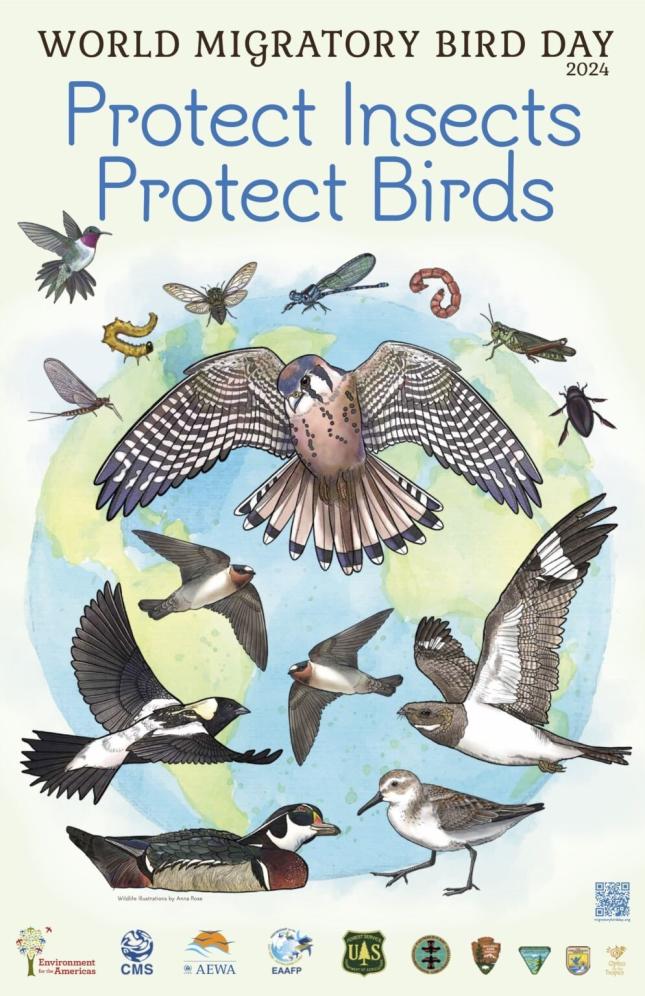Migratory Bird Day 2024: Protect Insects, Protect Birds “Water: Sustaining Bird Life”
 Last year, the focus of this day was water, essential for life. But for birds, insects are as essential to sustaining bird life on our planet and are the focus of World Migratory Bird Day 2024.
Last year, the focus of this day was water, essential for life. But for birds, insects are as essential to sustaining bird life on our planet and are the focus of World Migratory Bird Day 2024.
Insects are essential sources of energy for migratory birds, not only during the breeding seasons but also during their extensive journeys. Insects greatly affect the timing, duration, and overall success of bird migrations.
Along their migration routes, birds actively seek out insects in fields, forests, wetlands and any habitat they encounter during their stopovers. The timing of bird migration often coincides with peak insect abundance at stopover locations, supplying nourishment for birds to replenish their energy reserves before continuing their journeys. For example, Amur Falcons migrate from Siberia across India and the Arabian Sea to Africa. Their journey is sustained by several verdant valleys in India where dragonflies hatch just as the falcons pass through.
The loss and disturbance of insect populations at breeding sites and along avian migration routes threaten bird survival and well-being. Natural spaces like forests and grasslands that have been transformed or endangered by intensive agriculture and urban development and its effects such as light pollution can result in a decline in insect populations. Pesticides and herbicides designed to protect crops harm insects that birds rely on for food. A scarcity of energy- and protein-rich insects can hinder bird migration and breeding, leading to weakened immune systems, reduced reproductive success, and increased mortality rates for both adult birds and their offspring.
Birds play crucial roles in pollination and pest control, and a lack of insects disrupts these ecosystem functions. Overpopulation of certain insects, without natural predators from birds, can also cause outbreaks that damage plant health and agriculture.
The World Migratory Bird Day campaign in 2024 will stress the need for proactive conservation measures. This includes reducing the use of pesticides and fertilizers, and where possible, switching to organic farming. Other measures include maintaining and connecting areas of natural vegetation which provide food and shelter for birds and other species, in agricultural landscapes.
Clockwise from top left: Yellow-Billed Cuckoo, Northern Shoveler, Northern Waterthrush, Magellanic Penguin, Barn Swallow, Dickcissel, Wilson's Phalarope, American White Pelican, Osprey, Rufous Hummingbird. Original art by Augusto Silva.
The Birds of World Migratory Bird Day 2023
Ten bird species have been selected to serve as ambassadors and help tell the story of the importance of water to birds, representing not only the diversity of birds but also the variety of ways in which birds depend on healthy aquatic ecosystems. Northern Shoveler and American White Pelican remind us that many species need wetlands and open water for migration, wintering, and breeding. Some birds require specific types of water habitats, such as the salty lakes that Wilson’s Phalarope uses during migration and winter, the swampy woodlands favored by Northern Waterthrush, or the shaded streams along which the Yellow-billed Cuckoo nests. Water is essential for the survival of insects pursued by the Barn Swallow, the growth of nectar-producing plants frequented by the Rufous Hummingbird, and the health of grasslands inhabited by the Dickcissel. The Magellanic Penguin represents the oceans that make up 97% of all water on earth. Finally, the Osprey serves as a conservation success story, reminding us that bird population declines can be reversed when we work together to conserve and protect our planet.
Learn more about each species at this page.

